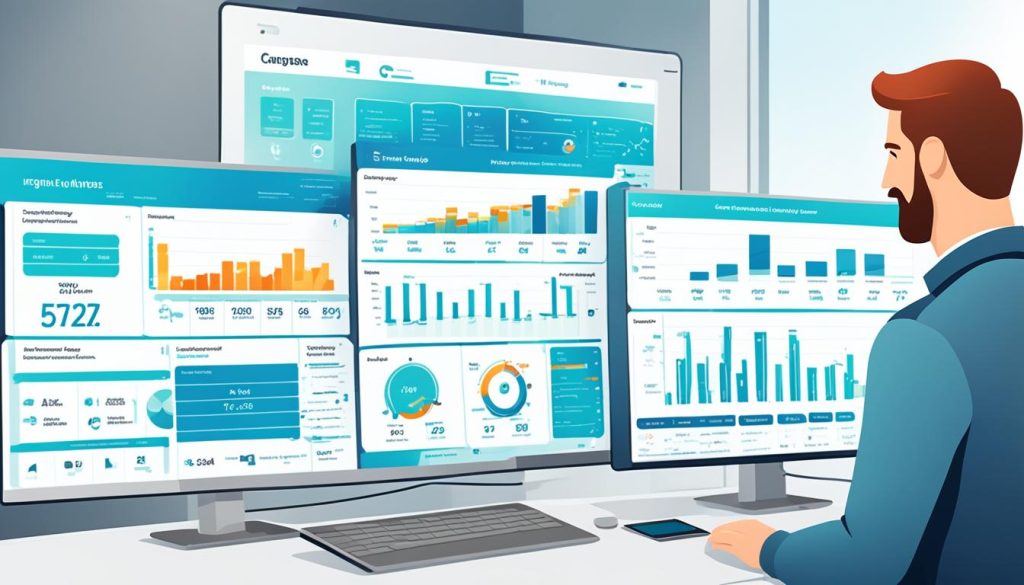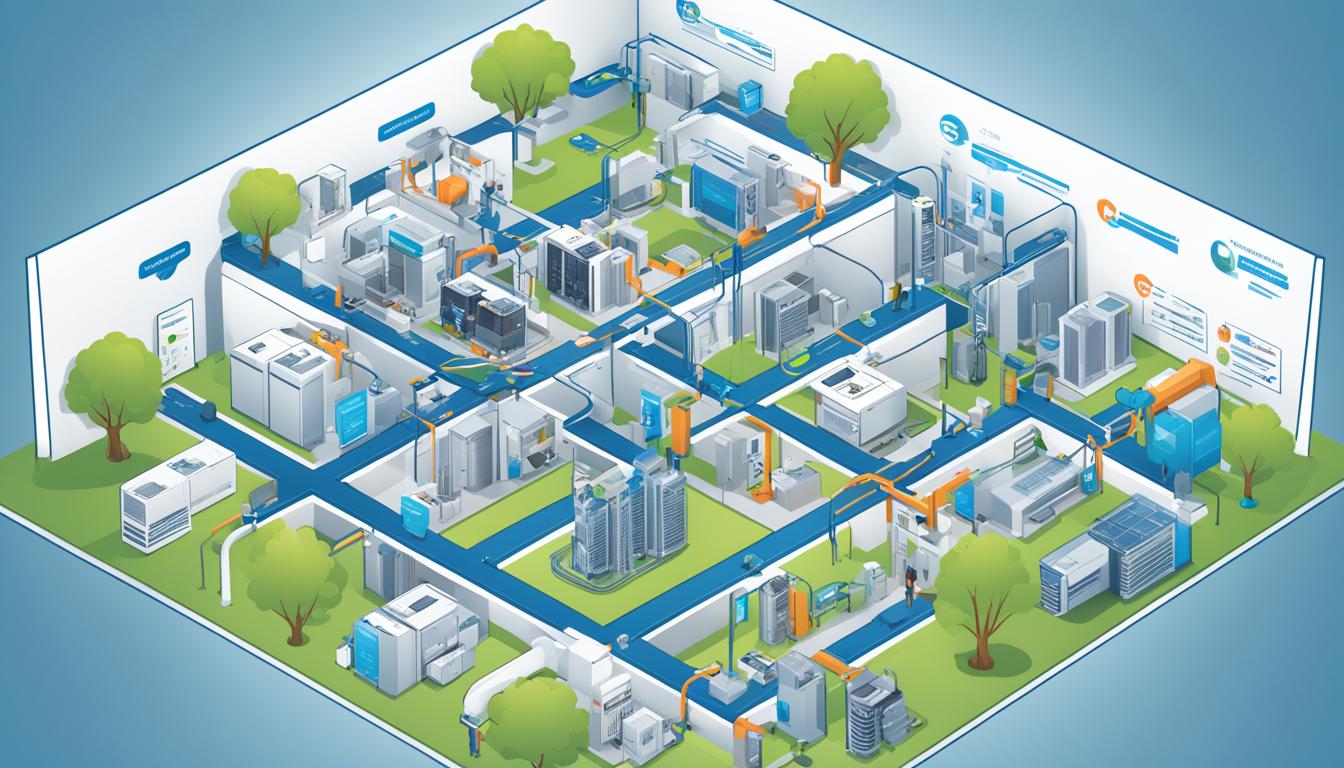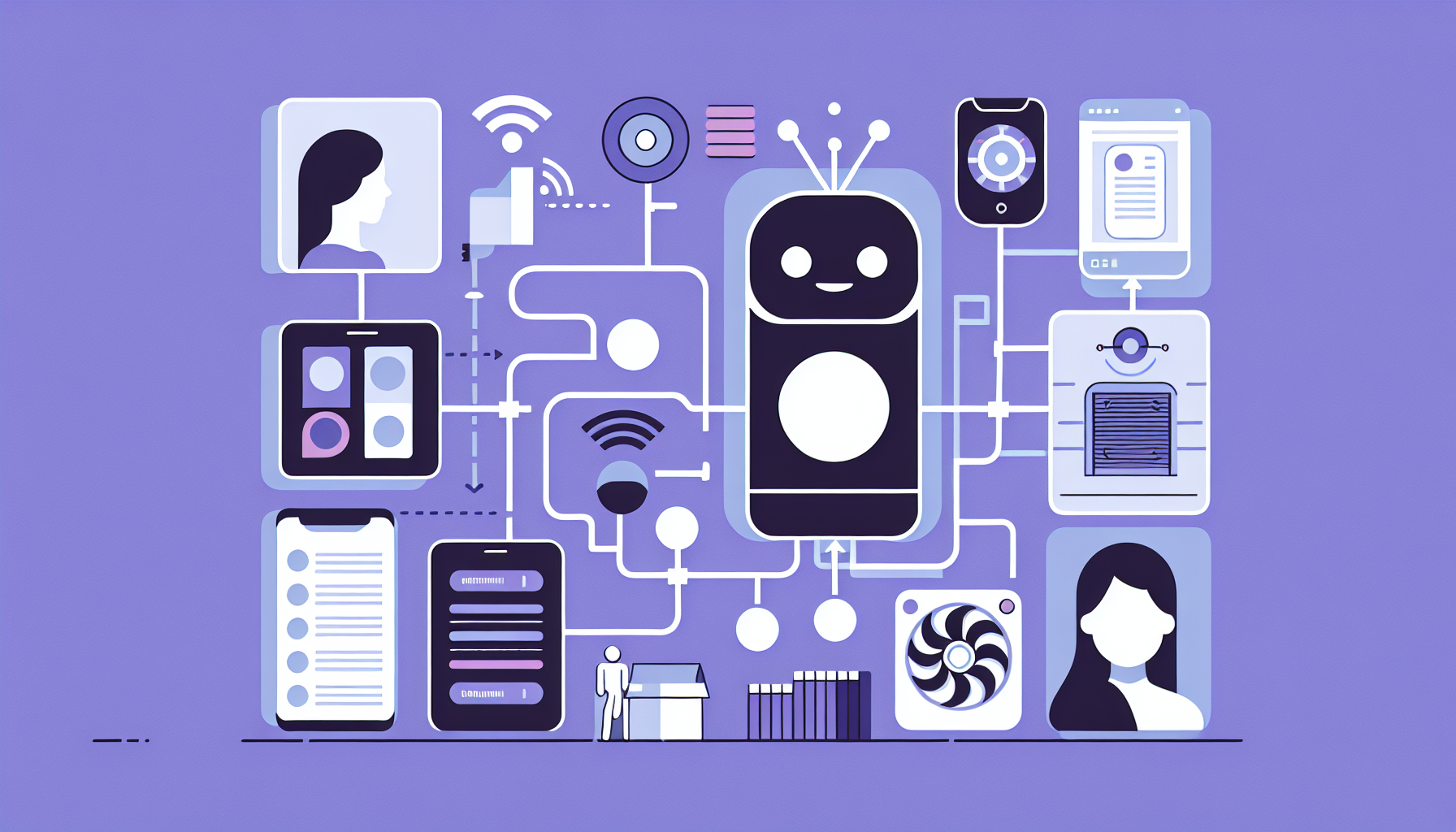Creating a seamless HVAC business ecosystem means using software that makes things run smoother and helps with customer service. By linking different HVAC systems and platforms, you get real-time data sharing and automation. This leads to better performance and smarter decisions.
Automation is key to staying ahead in today’s fast-paced market. With integrated HVAC software, you’re setting up a flexible and quick-to-react business. This not only cuts costs and energy use but also helps your company stay on top of changes and customer needs.
When you connect different systems, you get everything working together seamlessly. This lets you make decisions based on data, improve how you serve customers, and boost their happiness.
Understanding the Importance of HVAC Software Integration
HVAC software integrations have changed the game for businesses. They make it easier for companies to work together smoothly. Let’s look at how HVAC systems have evolved and why integrated solutions are key to success.
The Evolution of HVAC Systems and Software Platforms
HVAC systems used to rely on manual controls. Now, they’re smart and connected. With features like remote monitoring and energy optimization, they help businesses run better.
Benefits of Integrated HVAC Software Solutions
Integrated HVAC software brings big benefits:
- Improved operational efficiency
- Streamlined workflows
- Enhanced data accuracy
- Reduced manual errors
- Better decision-making capabilities
Using HVAC software integrations can boost your productivity and service quality. It makes sure different parts of your business work together smoothly, from scheduling to managing inventory.
Real-time Data Exchange and Synchronization
Real-time data exchange is a big plus of HVAC software integrations. It lets different systems talk to each other instantly. This cuts down on manual work and mistakes.
With data in sync across platforms, you can make quick, smart choices. This leads to happier customers and growing your business.
Key Components of a Seamless HVAC Business Ecosystem
A well-integrated HVAC business ecosystem uses tools and technologies to make things run smoother and more efficiently. By knowing these key parts, you can make your HVAC business more profitable and efficient.
Customer Relationship Management (CRM) systems are at the heart of your HVAC business. They help you keep track of client info, follow up with leads, and build strong relationships. When you link your CRM with other tools, you get a smooth flow of information throughout your company.
Inventory management software is key for keeping an eye on parts and equipment. It works well with your CRM and scheduling tools to avoid running out of stock and speed up service. This setup lets technicians see what parts they have right away, cutting down on delays and making customers happier.
Scheduling and dispatching tools help manage your team better. They work with your CRM and inventory to send the right tech to the right job. This way, everyone gets where they need to be faster, making your team more productive.
| Component | Function | Integration Benefits |
|---|---|---|
| CRM | Manage client relationships | Centralized customer data |
| Inventory Management | Track parts and equipment | Real-time stock updates |
| Scheduling | Optimize workforce | Efficient job assignments |
| Accounting | Financial management | Automated billing and reporting |
Adding accounting software to your HVAC business ecosystem makes it complete. It automates billing, payroll, and financial reports. This means you get accurate invoices based on the work done and parts used, cutting down on mistakes and improving cash flow.
Exploring HVAC Software Integration Technologies
HVAC software solutions have changed how heating, ventilation, and air conditioning work. They use advanced integration technologies. This makes businesses more efficient and productive. Let’s look at what makes HVAC data integration work.
Integration Frameworks and APIs
Integration frameworks and APIs are key to HVAC data integration. They let different software systems talk to each other easily. With APIs, HVAC software can connect with building management systems and customer databases. This means better decision-making and smoother operations.
Cloud-based Integration Solutions
Cloud technology has changed HVAC software integration. Cloud solutions are flexible and can grow with your business. They let you manage HVAC systems from anywhere, making things easier. Cloud integration also keeps all devices and systems up-to-date in real-time.
IoT Platforms for HVAC Systems
IoT platforms are changing HVAC systems. They connect devices and sensors, making HVAC smarter. IoT helps collect and analyze data for better maintenance and energy use. With IoT, HVAC software can give deeper insights into how systems work and how much energy they use. This leads to more efficient operations and savings.
| Integration Technology | Key Benefits | Application in HVAC |
|---|---|---|
| APIs | Seamless data exchange | Connecting HVAC with BMS |
| Cloud Solutions | Remote access and scalability | Multi-location HVAC management |
| IoT Platforms | Advanced analytics and control | Predictive maintenance and optimization |
Streamlining HVAC Operations with Integrated Software
HVAC business automation is changing the game. With software solutions, you can make your HVAC operations smooth and efficient. This boosts both efficiency and customer happiness. Let’s dive into how these tools change your daily tasks.

Integrated software makes your work easier by automating tasks. It takes care of scheduling and inventory management. Plus, it gives you real-time data to make quick decisions, enhancing your service.
Lead and Appointment Management
Smart software tracks leads and manages appointments with ease. It matches your schedule, sends reminders, and finds the best times for appointments. This is based on when your technicians are free and where they are.
Job Management
Tracking installations and maintenance is a breeze. The system gives out tasks, keeps an eye on progress, and updates clients automatically. This way, nothing gets missed.
Inventory Control
Manage your stock levels smartly with intelligent inventory management. The software predicts what you’ll need for jobs and past usage. This cuts down on waste and prevents stockouts.
Financial Precision
Get a clear view of your finances with integrated accounting features. Track expenses, create invoices, and check profitability easily. This helps you make smart business choices.
| Feature | Benefit |
|---|---|
| Automated Scheduling | Reduced booking errors |
| Real-time Updates | Improved technician efficiency |
| Inventory Forecasting | Optimized stock levels |
| Financial Reporting | Enhanced business insights |
By using these integrated solutions, you’re not just making things run smoother. You’re setting the stage for growth and excellence in your HVAC business.
Create a Seamless HVAC Business Ecosystem with Integrations
Creating a seamless HVAC business ecosystem is key to making your workflow better and more productive. By linking different systems and tools together, you can make things run smoother and work more efficiently. Let’s look at how to build this ecosystem with smart integrations.
Identifying Integration Opportunities
First, map out your current HVAC workflow to see where you can improve with integrations. Look for tasks that need manual data entry, repetitive steps, or where info is stuck in silos. These spots are great chances to make things better.
- Customer relationship management (CRM) systems
- Scheduling and dispatch software
- Inventory management tools
- Billing and invoicing platforms
- Field service management applications
Developing an Integration Strategy
Make a plan for how you’ll link your HVAC tools together. Think about how data will move, who can access it, and how you’ll keep it safe. Focus on integrations that will make the biggest difference in efficiency and customer happiness.
Implementing and Testing Integrations
After picking where to integrate and making a plan, it’s time to put it into action. Work with software makers or IT pros to make sure everything connects well. Test each integration well to check data accuracy and how the system works.
| Integration Step | Key Actions |
|---|---|
| Preparation | Data cleanup, system backups |
| Implementation | Software configuration, API setup |
| Testing | Data flow checks, user acceptance testing |
| Training | Staff education on new workflows |
| Monitoring | Performance tracking, issue resolution |
By taking these steps, you’ll build a seamless HVAC business ecosystem. This will boost productivity and streamline operations. Always check and update your integrations to keep up with your business’s changing needs.
Overcoming Challenges in HVAC Software Integration
HVAC software integrations offer many benefits but also have challenges. You must tackle these issues to make your business run smoothly. Let’s look at some common problems and how to beat them.
One big challenge is dealing with old systems. Many HVAC companies use outdated software that doesn’t work well with new systems. To fix this, use integration frameworks that can bridge the gap between old and new.
Another issue is making sure different systems work together. HVAC systems use various protocols, making integration hard. Use middleware solutions to translate between these protocols. This lets your systems talk to each other.
Cybersecurity is a big worry in HVAC software integrations. Connecting different systems can leave you open to threats. Use strong encryption and strict access controls to protect your system. Regular security checks can find and fix any weak spots.
For HVAC data integration to last, you need ongoing support and maintenance. Have a team or work with a trusted service to keep your systems updated and running well. This helps avoid problems and keeps your business efficient.
By facing these challenges, you can build a strong HVAC software system. This system will improve your operations and help you serve customers better.
Enhancing Customer Experience through Integrated HVAC Solutions
Integrated HVAC software solutions are changing how businesses talk to their customers. They make the HVAC business ecosystem smoother. This leads to happier customers and more loyalty.
Improved Response Times and Service Delivery
Integrated HVAC systems let technicians see real-time data on equipment and schedules. This means they can respond faster and work more efficiently. Customers get less downtime and their issues get fixed quicker.
Personalized Customer Interactions
HVAC software helps businesses keep track of customer info. This means service reps can quickly see what customers like and need. They can offer advice and support that fits the customer’s life.
Data-Driven Insights for Better Service
Using data from HVAC systems, businesses can fix problems before they start. This means less unexpected breakdowns and longer equipment life. Customers are happier, and it saves money too.
| Benefits of Integrated HVAC Solutions | Impact on Customer Experience |
|---|---|
| Real-time equipment monitoring | Faster problem detection and resolution |
| Centralized customer data | Personalized service and recommendations |
| Predictive maintenance | Reduced downtime and improved reliability |
| Automated scheduling | Convenient and timely service appointments |
By using these HVAC software solutions, businesses can make their services better and more focused on customers. This leads to happier customers, more loyalty, and growth for the business.
Maximizing Efficiency with Multi-Software Synchronization
Multi-software synchronization changes the game for HVAC workflow optimization. It connects different systems for smoother operations and boosts productivity. This method ensures data flows well across platforms, making it easier to monitor and schedule maintenance in real-time.
For HVAC businesses, automation with synchronized software is a big win. It lets you track important details, predict problems, and act early to prevent them. This way, you reduce downtime and improve system performance.

To use multi-software synchronization, you need to link various HVAC tools. This includes:
- Customer relationship management (CRM) systems
- Inventory management software
- Scheduling and dispatch tools
- Billing and invoicing platforms
- Equipment monitoring systems
When these systems work together, you get a full view of your HVAC business. This helps you make better decisions and use resources wisely. For instance, linking your CRM with scheduling software lets you assign technicians better based on their skills and where they are.
| Software Type | Function | Synchronization Benefit |
|---|---|---|
| CRM | Customer Data Management | Improved Service Personalization |
| Inventory Management | Parts Tracking | Reduced Stockouts |
| Scheduling | Technician Dispatching | Optimized Route Planning |
| Billing | Invoice Generation | Faster Payment Processing |
| Equipment Monitoring | System Performance Tracking | Predictive Maintenance |
By using multi-software synchronization, you make your HVAC business more efficient, quick, and competitive. This method not only makes your operations smoother but also makes customers happier with better service and more personalized interactions.
Future-Proofing Your HVAC Business with Scalable Integrations
To stay ahead in the HVAC industry, it’s crucial to use scalable integrations that keep up with new tech and market changes. This way, you’ll stay competitive and meet the changing needs of your customers.
Adapting to Emerging Technologies
Using HVAC software integrations is essential for adding the latest tech to your business. Cloud-based solutions and IoT platforms let you monitor and control HVAC systems from anywhere. This leads to better maintenance, energy use, and customer service.
| Emerging Technology | Benefits | Integration Challenges |
|---|---|---|
| Artificial Intelligence | Predictive maintenance, energy optimization | Data privacy, algorithm training |
| Internet of Things | Remote monitoring, real-time diagnostics | Device compatibility, network security |
| Virtual Reality | Enhanced technician training, remote assistance | Hardware costs, content development |
Preparing for Industry Changes
The HVAC industry is changing fast. Scalable integrations help you keep up with new rules, energy standards, and what customers want. Using HVAC productivity tools that work with your systems makes things run smoother and improves how you serve customers.
Continuous Improvement and Optimization
Future-proofing is an ongoing process. You need to keep checking and improving your systems regularly. Updating your HVAC software ensures you use the newest features and security updates. This keeps your business ready for future challenges.
By investing in scalable HVAC software and productivity tools, you’re setting your business up for success. These technologies make your operations better now and help you adapt to future needs.
Case Studies: Successful HVAC Business Ecosystems
Real-world examples show how HVAC companies have thrived with integrated business ecosystems. They’ve made their operations better by using seamless software integrations.
CoolTech Solutions: Revolutionizing Customer Service
CoolTech Solutions used a full CRM system with their scheduling and dispatching software. This move boosted customer satisfaction by 30% and cut response times by 25%.
AirFlow Experts: Data-Driven Decision Making
AirFlow Experts used data analytics to make their HVAC business better. They linked their inventory and job costing systems. This led to a 20% drop in inventory costs and a 15% boost in profit margins.
ComfortZone Inc: Streamlined Operations
ComfortZone Inc made their HVAC operations smoother by linking their field service software with their accounting. This change cut billing errors by 40% and reduced admin work by 35%.
| Company | Integration Focus | Key Results |
|---|---|---|
| CoolTech Solutions | CRM and Scheduling | 30% increase in customer satisfaction, 25% faster response times |
| AirFlow Experts | Inventory and Job Costing | 20% reduction in inventory costs, 15% improved profit margins |
| ComfortZone Inc | Field Service and Accounting | 40% fewer billing errors, 35% less administrative work |
These case studies show the big wins of a seamless HVAC business ecosystem. By linking key software, companies have boosted their efficiency, customer happiness, and profits.
Conclusion
Creating a seamless HVAC business ecosystem with integrations is key to success today. By using integrated software, you can change how your business works. This helps you give your customers the best service possible.
With real-time data exchange, you get insights to make smart choices. This makes your operations smoother, cuts down on mistakes, and increases efficiency. Your team can then focus on giving excellent HVAC services to your clients.
The HVAC industry is always changing. To stay ahead, invest in scalable integrations and new technologies. Remember, a seamless HVAC business ecosystem with integrations is more than just tech. It’s about making customers happy and growing your business in a changing world.





0 Comments